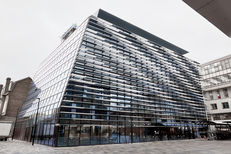For 120 years Camberwell College of Art has produced award-winning visual artists, designers, film-makers and musicians. In 2017, the University of the Arts London opened a £69M expansion to usher in a new era of creative arts education and involvement in the local community. The expansion includes teaching spaces, a library, public gallery and a hall of residence.
The expansion includes an energy efficient, on-site Energy Centre that harnesses combined heat and power and solar panels to reduce carbon emissions. Buildings are naturally ventilated using an automated and manual control strategy meaning mechanical cooling was ‘designed out’, saving over £839K in revenue costs over 25 years.
The University captured previous learning and was determined to narrow the gap between expected and realised energy performance. Building designers were required to consider the impact of their design on operational energy use at every design stage to ensure the building(s) exceed Building Regulations and Energy Performance Certificate ratings to deliver an outstanding student environment.
Top 3 learnings:
- We provide building designers and occupiers with clear guidance on how to evaluate operational energy use more fully and accurately at each design stage to meet specific carbon reduction targets.
- Our guidance enables building designers to estimate energy use more accurately, highlighting any areas where actual energy use may be higher than a typical building and allows design to follow desired outputs.
- We have proved natural ventilation in urban locations can and does work to reduce energy consumption and increase occupant wellbeing.
CO2t savings 2017/2018: 120 (Estimated to July ‘18)
CO2t savings 2018/2019: 160 (Estimated)
CO2t savings over the life cycle of the project: 4,000 (Estimated over 25 years)
Videos








 Except where otherwise stated, content on this site is
licensed under a Creative Commons Attribution 3.0 License.
Except where otherwise stated, content on this site is
licensed under a Creative Commons Attribution 3.0 License.
